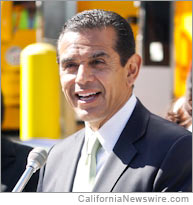 LOS ANGELES, Calif. /California Newswire/ — Mayor Villaraigosa delivered his sixth State of the City Address at Jefferson High School today, where he outlined his education reform priorities and reaffirmed his commitment to transform failing schools and improve learning throughout Los Angeles. “Now is the time to challenge the status quo by putting teacher effectiveness at the forefront of our educational agenda,” said Villaraigosa.
LOS ANGELES, Calif. /California Newswire/ — Mayor Villaraigosa delivered his sixth State of the City Address at Jefferson High School today, where he outlined his education reform priorities and reaffirmed his commitment to transform failing schools and improve learning throughout Los Angeles. “Now is the time to challenge the status quo by putting teacher effectiveness at the forefront of our educational agenda,” said Villaraigosa.
“Education reform is about more than reading, math, and test scores, it is about nurturing creativity and creating possibility. Working together, we can fulfill the promise of public education by agreeing to a new contract with ourselves, a promise to put aside the concerns of a few adults in the interest of all our children.”
In the address, Villaraigosa outlined three main education reform priorities that will improve educational opportunities for every student in Los Angeles. Specifically, he called for an increased investment in our public schools, providing schools with a more flexible teacher contract, and giving every family access to a diverse array of high-quality school options.
The first step in overhauling our educational system is addressing LAUSD’s severe under-funding problem. Los Angeles currently ranks 47th in the nation in per-pupil spending and is last in terms of student ratios for teachers, guidance counselors and librarians. To address this, Villaraigosa pledged his support for Governor Brown’s tax extension plan which will give California voters the opportunity to generate more revenue for schools by extending existing taxes. He also announced the formation of the “LA Fund for Public Education,” a partnership with the private sector to fundraise to invest in things like per-pupil funding, the development of a leadership pipeline, and promoting the arts.
Second, Villaraigosa discussed the importance of negotiating an empowerment contract for teachers that will provide flexibility, autonomy, and accountability. Villaraigosa called on LAUSD and UTLA to come together to negotiate a contract that allows individual school sites to develop their own methods to promote teacher effectiveness. This will empower teachers, granting them more freedom to write a curriculum that better caters to the unique needs of their students. An empowerment contract would also reward teachers that have a proven track record of effectiveness in the classroom, not just by seniority.
Lastly, Villaraigosa discussed the Public School Choice initiative and how it brings opportunity and innovation to LAUSD schools. He highlighted the host school, Jefferson High School, which participated in the first round of Public School Choice after being designated a “failing school.” Operation of Jefferson was awarded to an internal team of operators committed to data-driven accountability, regular classroom observation, and a curriculum that stresses college preparedness.
Jefferson is now run as five small schools, each with its own educational focus area. This model provides increased individualized attention on each student and has helped to raise Jefferson’s Academic Performance Index (API) score by 33 points. The school has also devoted more time and resources on family and community engagement, with the school reaching out to parents through door-knocking campaigns and regular calls home when students are lagging behind, absent or chronically late to class.
“At Thomas Jefferson High School, teachers and students are proving that we can dissolve even the most ominous clouds, and when those clouds part, we can see that the stars are clearly aligned,” Villaraigosa concluded. “This is our opportunity for reform. Let’s seize it together. Our kids are counting on us.”

















